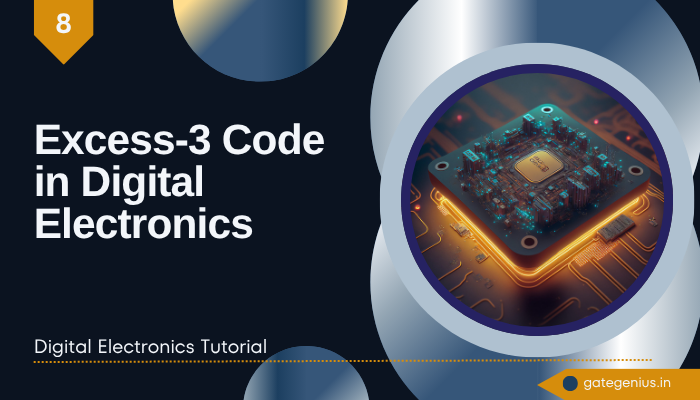One such important code is the Excess-3 Code, also known as XS-3 Code. It is widely used due to its unique properties like self-complementation and ease in arithmetic operations.One of the significant advantages of Excess-3 Code in Digital Electronics is its self-complementing nature, meaning the 9’s complement of a decimal number can be easily obtained by inverting each bit of the Excess-3 code. This feature is particularly useful in performing subtraction operations using addition in digital circuits, such as in digital calculators or ALUs (Arithmetic Logic Units).
Additionally, Excess-3 Code in Digital Electronics helps simplify circuit design when performing decimal arithmetic and is more suitable than straight binary or BCD in some situations due to reduced error possibilities. It also prevents invalid states as seen in standard BCD codes (where binary values 1010 to 1111 are invalid).
This blog explains the concept, features, examples, advantages, and applications of the Excess-3 code.
What is Excess-3 Code?
Excess-3 Code is a non-weighted binary code that represents each decimal digit by adding 3 to it and then converting the result into a 4-bit binary number. It is derived from the BCD (8421) code, but each digit is shifted by an excess of 3.
It is also called a self-complementing code, which means the 9’s complement of a decimal number can be obtained directly by complementing its Excess-3 code.
Why is it Called Excess-3?
It’s called Excess-3 because each decimal digit is converted to binary by adding 3 (0011 in binary) to it. This “excess” value shifts the standard BCD code upward.
Excess-3 Code Table
| Decimal Digit | BCD Code | Excess-3 Code |
|---|---|---|
| 0 | 0000 | 0011 |
| 1 | 0001 | 0100 |
| 2 | 0010 | 0101 |
| 3 | 0011 | 0110 |
| 4 | 0100 | 0111 |
| 5 | 0101 | 1000 |
| 6 | 0110 | 1001 |
| 7 | 0111 | 1010 |
| 8 | 1000 | 1011 |
| 9 | 1001 | 1100 |
How to Convert Decimal to Excess-3
Step 1: Add 3 to the decimal digit
Step 2: Convert the result into 4-bit binary
Example:
Decimal 4 → 4 + 3 = 7 → Binary of 7 = 0111 → Excess-3 code = 0111
Another Example:
Decimal 8 → 8 + 3 = 11 → Binary of 11 = 1011 → Excess-3 code = 1011
How to Convert Excess-3 to Decimal
Step 1: Convert the 4-bit binary to decimal
Step 2: Subtract 3 from the decimal number
Example:
Excess-3 code = 1001 → Decimal = 9 → 9 – 3 = 6
Features of Excess-3 Code
Excess-3 Code offers several unique features that make it an effective and widely used code for representing decimal digits in binary form. Below are the key features explained in detail:
1. Self-Complementing Code
One of the key features of Excess-3 Code is that it is a self-complementing code. This means the 9’s complement of any digit can be easily obtained by simply inverting all bits of the Excess-3 code. This feature simplifies subtraction operations in digital arithmetic circuits.
2. Non-Weighted Code
It is a non-weighted binary code. Unlike BCD or pure binary where each bit has a specific weight, Excess-3 does not assign fixed positional values to the bits. Despite being non-weighted, it still uniquely represents decimal digits from 0 to 9.
3. No Invalid States
A major advantage of Excess-3 Code in digital electronics is that it does not have invalid codes. While BCD allows invalid 4-bit codes like 1010 to 1111, Excess-3 uses only valid binary combinations from 0011 to 1100, covering all ten decimal digits with no unused patterns.
4. Simplifies Arithmetic Operations
Due to its structure, Excess-3 Code in digital electronics simplifies digital arithmetic operations like addition and subtraction. Its self-complementing property reduces the need for complex logic in designing digital circuits, making it ideal for calculators and ALUs.
5. Better Error Detection
It helps in basic error detection. Because its codes are not sequential like binary and differ in multiple bits for most digits, it becomes easier to spot certain errors during transmission or processing.
6. Easy Decimal to Binary Conversion
Excess-3 Code in digital electronics allows easy conversion from decimal. By adding 3 to each decimal digit and converting the result into binary, encoding becomes simple and consistent. This benefits both manual computation and hardware design.
Advantages of Excess-3 Code
1. Easy 9’s Complement Calculation
One of the main advantages of Excess-3 Code is its self-complementing property, which allows easy calculation of the 9’s complement. This is done by simply inverting all the bits of the Excess-3 representation, making it highly efficient for digital subtraction operations.
2. Simplifies Digital Subtraction Logic
Excess-3 Code in digital electronics helps in simplifying subtraction logic in digital systems. Since the 9’s complement can be calculated with ease, subtraction can be performed using addition methods, reducing the need for complex logic circuits.
3. Reduces Errors by Eliminating the 0000 Pattern
In Excess-3 Code, the binary pattern 0000 is not used. This eliminates a common source of errors in binary-coded systems and enhances the reliability of the code, especially during data transmission or switching.
4. More Suitable for Certain Arithmetic Logic Units
Itis often more suitable than BCD in specific arithmetic logic units. Its properties allow for faster and more efficient processing of decimal operations, making it a good choice in systems where optimized decimal arithmetic is important.
Disadvantages of Excess-3 Code
1. Less Efficient in Bit Usage
One of the major disadvantages of Excess-3 Code in digital electronics is its inefficiency in utilizing bits. While 4 bits can represent up to 16 combinations (0000 to 1111), Excess-3 uses only 10 combinations (0011 to 1100) to represent decimal digits 0 to 9. The remaining six combinations are unused, leading to wasted bit space compared to pure binary encoding.
2. Not Commonly Used in Modern Systems
Excess-3 Code in digital electronics is not as widely used today as other codes like BCD or ASCII. Most modern digital systems prefer standard binary or ASCII codes due to their compatibility with contemporary hardware and software environments. This limited use makes Excess-3 less practical in current technologies.
3. Requires Additional Conversion Logic
Another drawback of Excess-3 Code is the need for extra logic circuits to perform conversions between decimal and Excess-3. For example, converting a decimal number to Excess-3 involves adding 3 and then converting it to binary. This adds complexity to the hardware, increasing both cost and processing time.
4. No Positional Weight
It is a non-weighted code, meaning it lacks positional value like binary or BCD. This makes it less intuitive and more difficult for humans to interpret or analyze manually, especially when debugging or verifying logic in circuits.
5. Limited Application Scope
While Excess-3 Code is helpful for specific arithmetic operations, its use is largely restricted to niche applications. It does not support a broad range of functions like error correction, text representation, or data compression, which limits its relevance in advanced digital systems.
Applications of Excess-3 Code in Digital Electronics
1. For Subtraction and Complements
Excess-3 Code in digital electronics is ideal for systems that frequently perform subtraction. Its self-complementing feature allows easier implementation of 9’s complement operations, reducing circuit complexity.
2. In Digital Calculators
Older digital calculators used to perform decimal arithmetic efficiently using binary logic, simplifying design before modern processors became common.
3. For Error Detection
Excess-3 Code helps in basic error detection due to its structured code format and absence of certain bit patterns like 0000, aiding in identifying invalid inputs.
4. In Digital Electronics Education
It is commonly used in educational contexts to teach code conversion, complements, and properties of non-weighted binary codes, helping learners understand binary logic systems.
Frequently Asked Questions?
Q1. Is Excess-3 code weighted or non-weighted?
A1. It is a non-weighted code.
Q2. What is the main advantage of Excess-3 code?
A2. It is a self-complementing code, making subtraction operations easier.
Q3. How do you get the 9’s complement using Excess-3?
A3. Simply take the 1’s complement (bit-wise NOT) of the Excess-3 code. It directly gives the Excess-3 code of the 9’s complement.
Q4. Is Excess-3 more efficient than BCD?
A4. In terms of arithmetic operations like subtraction, yes. But for data storage or processing, BCD is more commonly used.
Q5. Why do we use 4 bits for each digit in Excess-3?
A5. Because we’re still dealing with decimal digits (0–9), and each digit is encoded as a 4-bit binary after adding 3.
Conclusion
Excess-3 is an important digital code that builds on the BCD format by adding an offset of 3. It offers several advantages such as ease of complement operations and error reduction, making it useful in certain digital electronics applications, especially in arithmetic processing.
I hope you understand the Excess-3 Code in Digital Electronics. So don’t forget to share this post with friends and anyone preparing for the GATE, UGC NET exams, or studying at the university.



